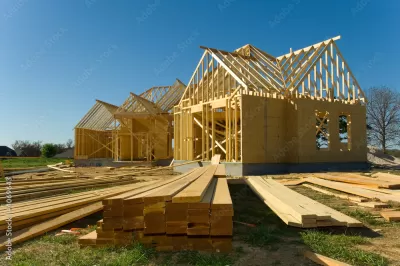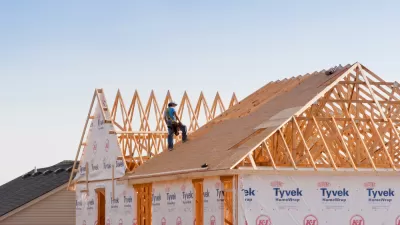U.S. homes are adding bedrooms while getting smaller, according to two seemingly contradictory articles published on the same day from different data sources earlier this month.

Contradictory conclusions about the direction of the new-build housing market circulated online on the same day this month.
On August 22, an article by Justin Fox for Bloomberg included the following data to support an article about the increasing number of bedrooms in newly constructed housing units.
Of the just over a million new single-family houses completed in the US last year, 490,000 had four or more bedrooms. That worked out to a 48% share, the highest since the US Census Bureau started keeping track in 1973—and more than double the percentage in 1973.
Another article, by Maggie Eastland for the Wall Street Journal [paywall], reported on generally shrinking footprints of new housing construction:
Since 2018, the average unit size for new housing starts has decreased 10% nationally to 2,420 square feet, according to Livabl by Zonda, a listing platform for new construction homes. Construction starts for new single-family homes declined in 2022. But starts for homes with fewer than three bedrooms increased 9.5% over the same period, according to a Zillow report.
The stories don’t totally reach opposite conclusions, however. Fox’s coverage acknowledge’s that the increase in the number of bedrooms doesn’t necessarily mean a commensurate increase in square footage:
While the median floor area of new single-family houses rose slightly in 2022, to 2,299 square feet, it’s still below pre-pandemic levels, and quarterly statistics on housing starts indicate that it will fall in 2023. But the uses to which that space is put are changing.
Further complicating any simple interpretation of the two stories are the explanations behind each of the trends reported by these two articles. Both assumptions seem reasonable: Americans want more bedrooms to facilitate working from home, according to the story about homes adding bedrooms, and less square footage is intended to lower the cost of housing, according to the story about homes decreasing in square footage.
FULL STORY: Never Mind Shrinking Households, Builders Are Adding Bedrooms

Maui's Vacation Rental Debate Turns Ugly
Verbal attacks, misinformation campaigns and fistfights plague a high-stakes debate to convert thousands of vacation rentals into long-term housing.

Planetizen Federal Action Tracker
A weekly monitor of how Trump’s orders and actions are impacting planners and planning in America.

In Urban Planning, AI Prompting Could be the New Design Thinking
Creativity has long been key to great urban design. What if we see AI as our new creative partner?

How Trump's HUD Budget Proposal Would Harm Homelessness Response
Experts say the change to the HUD budget would make it more difficult to identify people who are homeless and connect them with services, and to prevent homelessness.

The Vast Potential of the Right-of-Way
One writer argues that the space between two building faces is the most important element of the built environment.

Florida Seniors Face Rising Homelessness Risk
High housing costs are pushing more seniors, many of them on a fixed income, into homelessness.
Urban Design for Planners 1: Software Tools
This six-course series explores essential urban design concepts using open source software and equips planners with the tools they need to participate fully in the urban design process.
Planning for Universal Design
Learn the tools for implementing Universal Design in planning regulations.
Gallatin County Department of Planning & Community Development
Heyer Gruel & Associates PA
JM Goldson LLC
City of Camden Redevelopment Agency
City of Astoria
Transportation Research & Education Center (TREC) at Portland State University
Jefferson Parish Government
Camden Redevelopment Agency
City of Claremont




























